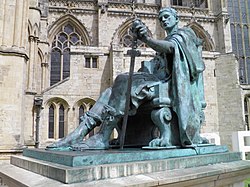| Statue of Constantine the Great | |
|---|---|
 | |
| Artist | Philip Jackson |
| Year | 1998 |
| Location | Minster Yard, York Minster, York, England |
The Statue of Constantine the Great is a bronze statue depicting the Roman emperor Constantine I seated on a throne, commissioned by York Civic Trust and designed by the sculptor Philip Jackson. It was unveiled in 1998 and is situated on Minster Yard, outside York Minster. It commemorates the accession of Constantine as Roman emperor in AD 306 on this site, after the death of his father Constantius Chlorus in York. [1]





